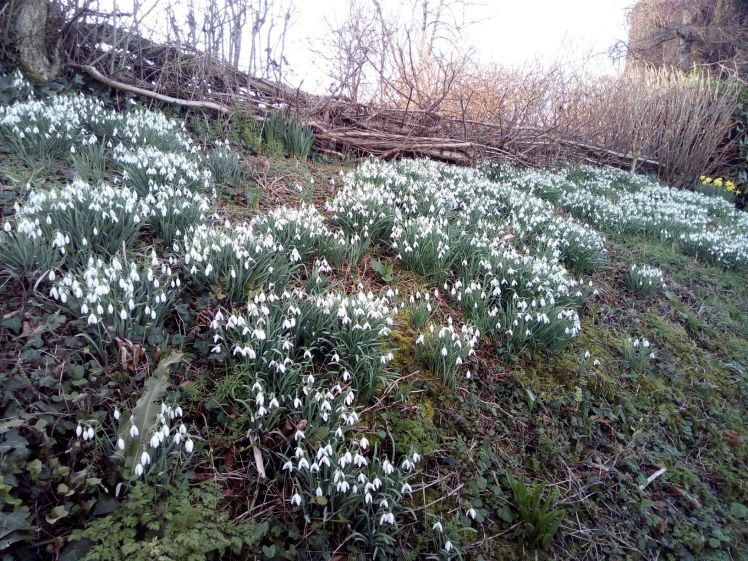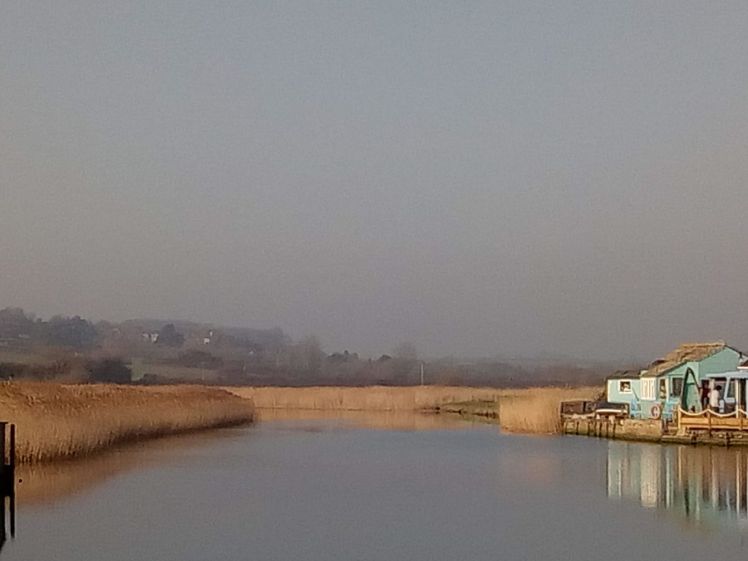Spring has come early in 2019 in the Northern Hemisphere. It’s a wonderful thing to enjoy some sunshine and warmth. Such are the fleeting pleasures of unwanted climate change.
Snowdrops in January and February are something we can expect to enjoy after Christmas. A brightening of the new year.

There are the beautiful colours of bare branches against a blue winter sky.

Here in West Dorset there always the delights of being near the seaside. When I see these bleached rushes on the River Brit as it nears West Bay it makes me think of times long ago, before there were houses here, and centuries before the harbour was built.

With so few landing places along this coast, it’s not too hard to imagine Viking invaders finding their way inland. Or traders heading for the Roman road.

(At one time I was interested in buying that blue cabin until a friend pointed out that the wall appeared to be made of sandbags. After that it was the home of David Tennant’s character in ‘Broadchurch’ and became a tourist attraction.)
One of the things I like best about the dead of winter is the feeling that time stands still – even if that’s only a feeling.
But this year, the warm weather has hastened the coming of Spring.

I’m glad we planted crocuses in the autumn so there’s something open now for those early solitary bees and hover-flies. Every year, with small changes, we try to help the wildlife along. I would love to see more flowers on the verges everywhere.
The view from my writing window is always changing. Here it is at the beginning of February.

Since then we have had the warmest February since records began. Despite the frosts mornings, the magnolia tree in front of the house in this picture is showing white tips that grow bigger by the day.

Could it be that the magnolia is already in bloom? It’s usually due out in April. I had to take a closer look.

Gorgeous as they are I hope these don’t suffer if we have the same kind of March as last year, with two lots of snow and an assault from the icy wind known as ‘The Beast from the East’.
As I write a bumble bee is battering itself against the window. I can only hope it hasn’t used up too much energy trying to fly through the building instead of around it. At least there is a chance of finding food.
So many flowers are out early. As well as lesser celandines, daffodils and primroses, the grape hyacinths and even the camellia in its sunny spot (not pictured here) are coming into bloom.

Celandines 27 Feb 2019 
Dorset daffs 27 February 2019 
Primroses in the garden 27 February 2019 
Grape hyacinth with solitary bee 27 February 2019
The birds are busy courting and finding their nest sites. This morning I watched two blackbirds vying for one female. There are daily battles. The blue tits meanwhile are considering the nest box that was home to a brood last year. What a proud achievement that was for this tiny garden!

Six babies fledged and flew, leaving behind this one egg in the nest, unhatched. The nest box is back in place, ready for a new brood – if we should be so lucky again.
It’s all as uncertain as the weather and the future: so we enjoy the sunshine while we may. The first blossoms fading remind us of time speeding on, but while we can, let’s experience the glory!

Bridport-West Bay
27 February 2019
What has February been like in your part of the world? Are you noticing the effects of climate change?
Is there anything you’re doing to help wildlife, particularly birds and insects?
Do you have tips or experiences to share?
Glorious photos! My early childhood was in Melbourne, Australia, and back then in baby boomer times we were more strongly part of the Commonwealth so text books and children’s book were mostly British. Your photos gave me a jolt back to all the beautiful, evocative books I read. Often with hand-drawn illustrations, I think I absorbed English plant names better than Australian ones. Melbourne gets much colder than Brisbane so I remember ‘anyone who was anyone’ had a magnolia tree growing in their front garden.
LikeLiked by 1 person
Thanks – I enjoy knowing how all this Northern Hemisphere stuff comes across to you in Australia. You fit so much history and experience into that one comment: makes me want to see things where you are too.
LikeLiked by 1 person
That’s very lovely of you to say so. The quote ‘same-same but different’ applies I think. Maybe you could plan a book tour 🙂 Our native wildlife here in suburbia consists of possums, native bees (stingless), flocks of birds both European and Australian and because it has been an exceedingly hot summer, we put out bowls of water. Even the lizards need a sip!
LikeLiked by 1 person
A book tour! I hadn’t thought of that. All your wildlife stories are fascinating to me. I welcome guest posts about these things too 😉 to get the perspective from places that are not ‘here’.
LikeLiked by 1 person
Ooh, that sounds good. Gives me something to think about! I’m working on a post of my recent early morning visit to our botanical gardens and I did think ‘what a contrast’ when I saw your post. I cringe saying this, but if you type key words into the search bar on my blog, e.g. koala, Mt Coot-tha, Brisbane, garden notes, etc, up will come previous posts of my general neighbourhood.
LikeLiked by 1 person
Brilliant! Perhaps I might reblog something? If I can work out how to do that with your permission.
LikeLiked by 1 person
Exciting! Yes, you have my permission. I don’t activate Comments so usually a blogger will ask for confirmation via my Contact page. If nothing takes your fancy I can offer my forthcoming botanical gardens visit.
LikeLiked by 1 person
Excellent, thank you. I will have a look.
LikeLiked by 1 person
Everything has been bursting into life a little earlier each year in our area, too. On the one hand it’s lovely seeing the blossoms, but I do find it worrying. All I can do is try to keep the bird feeders topped up, and stop worrying about weeding – dead nettles seem to flower early too, and I’ve got a carpet of them.
LikeLiked by 1 person
Dead nettles, despite the name, could be attractive ground cover! And I think that bumble bees and mason bees can feed on them so that’s helping too. The blossoms are coming early and going early, which always feels like spring is rushing by. Still beautiful though.
LikeLiked by 1 person